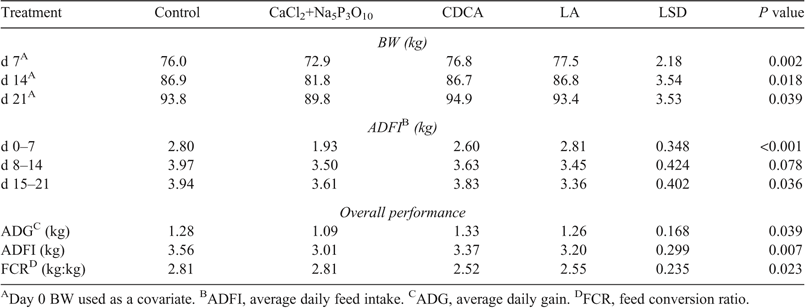Suppressing the feed intake of finisher pigs: a preliminary study
J. R. Pluske A E , J. L. Black B , J. C. Kim C and F. R. Dunshea DA Murdoch University, Murdoch, WA 6150.
B John L. Black Consulting, Warrimoo, NSW 2774.
C Department of Agriculture and Food, South Perth, WA 6151.
D The University of Melbourne, Parkville, VIC 3010.
E Corresponding author. Email: J.Pluske@murdoch.edu.au
Animal Production Science 55(12) 1546-1546 https://doi.org/10.1071/ANv55n12Ab063
Published: 11 November 2015
Manipulation of voluntary feed intake in finisher pigs is potentially a tool for the Australian pork industry to regulate seasonal impacts on finisher pig growth performance and carcass quality, and allow some control over annual pork supply. The general hypothesis tested in this preliminary study was that the strategic use of selected feed ingredients could decrease feed intake in finisher pigs.
A total of 28 individually-housed female pigs (Large White x Landrace) with a starting body weight (BW) of 66.9 ± 0.19 kg (mean ± SD) was used in a randomised complete block design study to examine the effects of several dietary additives (n = 7 pigs per diet) on performance in the finisher period. The diets were: a commercial Control diet [13.8 MJ digestible energy (DE)/kg, 153 g/kg crude protein, 0.59 g available lysine/MJ DE; Reid Stockfeeds, VIC]; Control diet plus 4% CaCl2+2.2% Na5P3O10; Control diet plus chenodeoxycholic acid (CDCA; 120 mg/kg body weight); and Control diet plus 5% lauric acid (LA). Diets 2 and 4 were prepared in 200 kg batches using a cement mixer to incorporate the additives, whereas the CDCA in diet 3 was given as a daily top-dress to the pigs’ feed. Pigs were fed ad libitum for 21 days towards the end of the finisher phase. Water was available on an ad libitum basis. Data were analysed using GLM (Genstat, 15th Edition; UK), and least significant difference (LSD) at α = 0.05 was used to separate treatment means.
There were acceptance issues in pigs offered 4% CaCl2 + 2.2% Na5P3O10 in the first week, so subsequently the inclusion rate was halved for each additive (to 2% CaCl2 + 1.1% Na5P3O10). Overall, ADFI was lowest (P = 0.007) in pigs fed CaCl2 + Na5P3O10 (15% lower than Control pigs) but was not different (P > 0.05) to pigs fed LA, which in turn was similar (P > 0.05) to pigs fed CDCA. This resulted in pigs fed CaCl2 + Na5P3O10 being the lightest (P = 0.039) at the end of the feeding period. Pigs fed LA consumed 10% less feed (P = 0.007) than pigs fed the Control diet, but had similar performance. Pigs fed CDCA or LA showed a better FCR (P = 0.023) relative to pigs fed CaCl2 + Na5P3O10 or the Control diet (an average of 9%) over the 21-day period (Table 1). These data indicate that a reduction in feed intake can be achieved in finisher pigs, with the appetite suppressing effects of CaCl2 + Na5P3O10 possibly working through induction of metabolic acidosis (Yen et al. 1981), and those of LA most likely working through appetite suppression mechanisms such as reduced gastric emptying and (or) increased secretion of appetite-suppressing hormones in the gastrointestinal tract (Little et al. 2007).

|
References
Little TJ, Russo A, Meyer JH, Horowitz M, Smyth DR, Bellon M, Wishart JM, Jones KJ, Feinle-Bisset C (2007) Gastroenterology 133, 1124–1131.| Crossref | GoogleScholarGoogle Scholar |
Yen JT, Pond WG, Prior RL (1981) Journal of Animal Science 52, 778–782.
This project was funded by Australian Pork Limited. Appreciation is extended to Messrs Fan Liu and Ashley Gabler for assistance.


